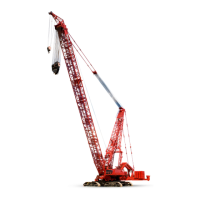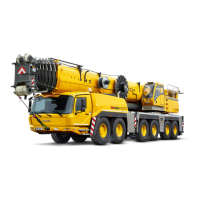Manitowoc Published 10-01-12, Control # 044-05 v2 3-45
777 OPERATOR’S MANUAL OPERATING CONTROLS AND PROCEDURES
3
See Table 3-6 for a list of abbreviations used and Table 3-7
for drum identification.
Operating Conditions
Table 3-3 lists operating conditions which can be displayed
and the normal operating range of each.
When an operating condition is selected (such as ENGINE
SPEED), the current status of the condition displays (see
Figure 3-27).
Operating Limits
Table 3-4 lists operating limits which can be displayed.
When one or more operating limits is reached, the operating
limit alert (yellow light and buzzer in cab) turns on to warn the
operator. At the same time, the operating limit display
immediately appears (see Figure 3-28) and automatically
scrolls through the names of the limits, stopping at each for
approximately three seconds.
The operating limit alert turns off when the cause of each
limit is corrected. The name of each limit reached during
operation is retained in memory, however, until two things
happen:
1. Name of limit appears on display at least once.
2. Cause of limit is corrected.
For this reason, it is normal for the names of limits to appear
when you scroll to the operating limit group, even when
operating limit alert is off.
To erase names of inactive limits, scroll to operating limit
group. Wait until display scrolls through the name of each
limit. The names of inactive limits will be erased
automatically. If the alert is on, only the names of active limits
will remain.
NO FAULT appears on the display (see Figure 3-29) when
no limits have been reached.
System Faults
Table 3-5 lists system faults which can be displayed.
When one or more system faults occur, the system fault alert
(red light and beeper in cab) turns on to warn the operator. At
the same time, the system fault display immediately appears
(see Figure 3-30) and automatically scrolls through the
names of the faults, stopping at each for approximately three
seconds.
The system fault alert turns off when the cause of each fault
is corrected. The name of each fault that has occurred during
operation is retained in memory, however, until two things
happen:
1. Name of fault appears on display at least once.
2. Cause of fault is corrected.
For this reason, it is normal for the names of faults to appear
when you scroll to the system fault group, even when system
fault alert is off.
To erase names of inactive faults, scroll to system fault
group. Wait until the display scrolls through the name of each
fault. The names of inactive faults will be erased
automatically. If the alert is on, only the names of active faults
will remain.
NO FAULT appears on the display (see Figure 3-31) when
there are no faults.
Selecting Display Language
The display can be viewed in English or one of several other
languages. Once the desired language is selected, it will
remain in memory until another language is selected.
To select a different display language, perform both of the
following steps at the same time:
1. Depress limit bypass switch.
2. Turn crane mode selector key to “confirm” position.
Repeat the steps until the screen displays the desired
language.
FIGURE 3-27
ENGINE SPEED
900 RPM
FIGURE 3-28
OPERATING LIMIT
BLOCK UP
FIGURE 3-29
OPERATING LIMIT
NO FAULT
FIGURE 3-30
SYSTEM FAULT
DRUM 1 SPEED
FIGURE 3-31
SYSTEM FAULT
NO FAULT

